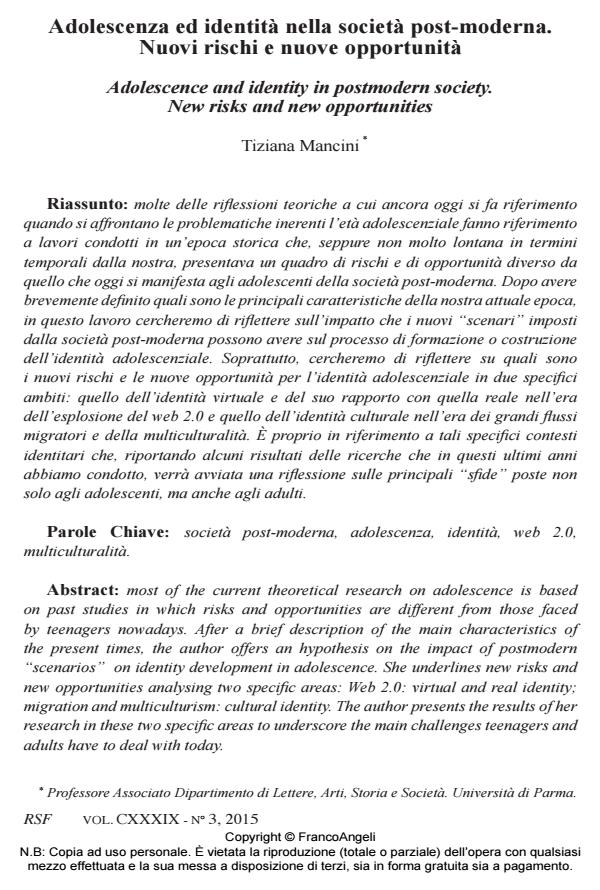Adolescenza ed identità nella società post-moderna. Nuovi rischi e nuove opportunità
Titolo Rivista RIVISTA SPERIMENTALE DI FRENIATRIA
Autori/Curatori Tiziana Mancini
Anno di pubblicazione 2015 Fascicolo 2015/3
Lingua Italiano Numero pagine 18 P. 29-46 Dimensione file 2194 KB
DOI 10.3280/RSF2015-003003
Il DOI è il codice a barre della proprietà intellettuale: per saperne di più
clicca qui
Qui sotto puoi vedere in anteprima la prima pagina di questo articolo.
Se questo articolo ti interessa, lo puoi acquistare (e scaricare in formato pdf) seguendo le facili indicazioni per acquistare il download credit. Acquista Download Credits per scaricare questo Articolo in formato PDF

FrancoAngeli è membro della Publishers International Linking Association, Inc (PILA)associazione indipendente e non profit per facilitare (attraverso i servizi tecnologici implementati da CrossRef.org) l’accesso degli studiosi ai contenuti digitali nelle pubblicazioni professionali e scientifiche
Molte delle riflessioni teoriche a cui ancora oggi si fa riferimento quando si affrontano le problematiche inerenti l’età adolescenziale fanno riferimento a lavori condotti in un’epoca storica che, seppure non molto lontana in termini temporali dalla nostra, presentava un quadro di rischi e di opportunità diverso da quello che oggi si manifesta agli adolescenti della società post-moderna. Dopo avere brevemente definito quali sono le principali caratteristiche della nostra attuale epoca, in questo lavoro cercheremo di riflettere sull’impatto che i nuovi "scenari" imposti dalla società post-moderna possono avere sul processo di formazione o costruzione dell’identità adolescenziale. Soprattutto, cercheremo di riflettere su quali sono i nuovi rischi e le nuove opportunità per l’identità adolescenziale in due specifici ambiti: quello dell’identità virtuale e del suo rapporto con quella reale nell’era dell’esplosione del web 2.0 e quello dell’identità culturale nell’era dei grandi flussi migratori e della multiculturalità. È proprio in riferimento a tali specifici contesti identitari che, riportando alcuni risultati delle ricerche che in questi ultimi anni abbiamo condotto, verrà avviata una riflessione sulle principali "sfide" poste non solo agli adolescenti, ma anche agli adulti.
Parole chiave:Società post-moderna, adolescenza, identità, web 2.0, multiculturalità
Tiziana Mancini, Adolescenza ed identità nella società post-moderna. Nuovi rischi e nuove opportunità in "RIVISTA SPERIMENTALE DI FRENIATRIA" 3/2015, pp 29-46, DOI: 10.3280/RSF2015-003003